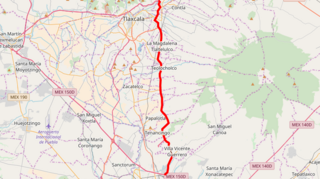The Arco Norte, designated and signed as Federal Highway M40D, is a toll road in Mexico. It serves as a bypass around Greater Mexico City and currently links the Mexico-Puebla toll road on the east with the Mexico-Guadalajara toll road on the west.
Federal Highway 180D is the toll highways paralleling Highway 180 in seven separate segments of highway. Three are in Veracruz:, the Libramiento de Cardel, the highway from Cardel to Veracruz, and the Nuevo Teapa-Cosoleacaque highway. Four segments exist beyond Veracruz: one between Agua Dulce and Cárdenas, Tabasco, facilitating a connection from the city of Coatzacoalcos in Veracruz; a bypass of Villahermosa; one connecting Champotón to Campeche City, Campeche; and another connecting the cities of Mérida, Yucatán, and Cancún, Quintana Roo. An additional segment, connecting the latter highway to Playa del Carmen, is officially part of Highway 180D, but is signaged as Highway 305D.
Federal Highway 70D is the designation for toll highways paralleling Mexican Federal Highway 70.
Federal Highway 95D is a toll highway connecting Mexico City to Acapulco, Guerrero. Highway 95D is among the most important toll roads in the country, serving as a backbone for traffic out of Mexico City toward Morelos and tourist destinations in Guerrero.
Federal Highway I-20D, known as the Libramiento de Irapuato, is a toll highway that serves as a bypass of the city of Irapuato, Guanajuato. The road is operated by HOATSA, which charges 68 pesos per vehicle to travel the full course of the highway. The road opened on March 15, 2011 at a construction cost of 900 million pesos.
Federal Highway 200D is the toll highways paralleling Fed. 200, and has two separate improved segments of designated roadway. Fed200D in Colima funnels traffic from Manzanillo toward Fed110 to Colima City; the segment in Guerrero serves as a bypass of Tecpan de Galeana.
Federal Highway 150D is a toll highway connecting Mexico City to Veracruz City via Puebla City and Córdoba. It serves as one of the backbones of Mexico's toll road system. The road is primarily operated by Caminos y Puentes Federales, which charges cars 520 pesos to travel Highway 150D, with one segment in the Puebla metropolitan area built and maintained by OHL and PINFRA.
Federal Highway 140D is a toll (quota) part of the federal highways corridors that connects Puebla City to Xalapa.
Federal Highway 145D is a toll highway in the state of Veracruz. It connects southern Veracruz to Mexican Federal Highway 150D, continuing the other road's east-west trajectory. The road is operated by Caminos y Puentes Federales, who charges a toll of 183 pesos per car to travel Highway 145D.
Federal Highway 135D is a toll highway connecting Cuacnopalan, Puebla to Oaxaca City and bypassing Tehuacán,Puebla. The road is operated by Caminos y Puentes Federales, which charges a toll of 200 pesos per car to travel Highway 135D.
Federal Highway 15D is the name for toll highways paralleling Federal Highway 15. The toll segments of Highway 15D include some of the most significant highways in the country along the Nogales-Mexico City corridor. The highway is the southern terminus of the CANAMEX Corridor, a trade corridor that stretches from Mexico north across the United States to the Canadian province of Alberta.
Federal Highway 2D is a part of the federal highways corridors, and is the designation for toll highways paralleling Mexican Federal Highway 2. Seven road segments are designated Highway 2D, all but one in the state of Baja California, providing a toll highway stretching from Tijuana in the west to around Mexicali in the east; one in Sonora, between Santa Ana and Altar; and another between the cities of Matamoros and Reynosa in Tamaulipas.
Federal Highway 40D is the designation for toll highway paralleling Mexican Federal Highway 40. Highway 40D connects Mazatlán, Sinaloa to Reynosa, Tamaulipas. It forms most of the highway corridor between Mazatlán and Matamoros, Tamaulipas, one of 14 major highway corridors in the country.
Federal Highway 45D is a tolled part of the paralleling Fed. 45. Eleven separate tolled segments exist of Fed. 45D between Querétaro City and Villa Ahumada in Chihuahua, between Chihuahua City and Ciudad Juárez.
Federal Highway 119D is a toll highway connecting Tejocotal, Hidalgo to Tlaxco Municipality, Tlaxcala. The road is operated by Promotora y Operadora de Infraestructura S.A. de C.V. (PINFRA).
Federal Highway 190D is the tolled Federal Highway that parallels Federal Highway 190. Highways with the 190D signage are in the states of Oaxaca and Chiapas.
Federal Highway 132D is the designation for toll highways paralleling Mexican Federal Highway 132. Highway 132D forms most of the Mexico City-Tuxpan highway corridor, with contiguous segments in the State of Mexico and from Tulancingo, Hidalgo to Tihuatlán, Veracruz.
Federal Highway 57D (Fed. 57D) is a tolled (cuota) part of the federal highways corridor of the paralleling Fed. 57. Eight separate tolled segments exist of Fed. 57D between Mexico City and Allende, Coahuila; a ninth is part-federal and part-state.
The Macrolibramiento Palmillas-Apaseo el Grande, also known as the Libramiento Centenario de la Constitución de 1917, is a toll highway in the Mexican states of Querétaro and Guanajuato, designed to serve as a large-scale bypass of Querétaro City and San Juan del Río, signed as Mexican Federal Highway 47D. It is operated by Empresas ICA and carries a toll of 75 pesos per car and 37 pesos per motorcycle.




